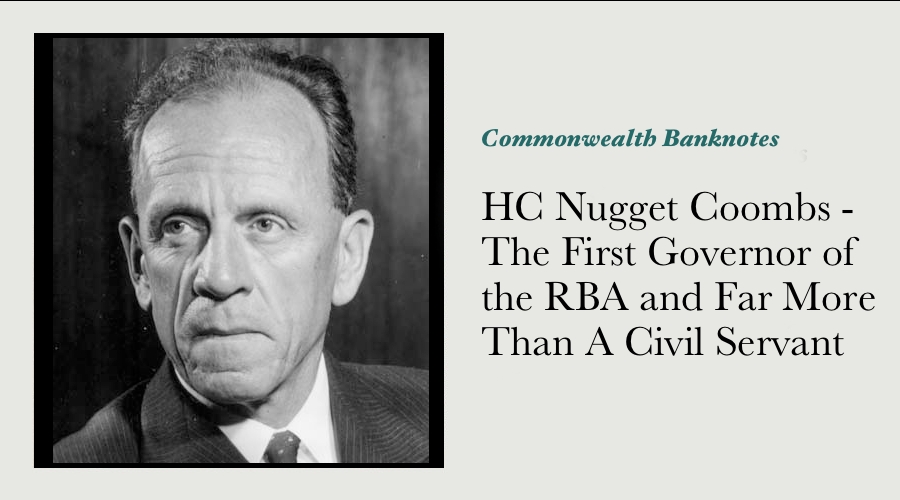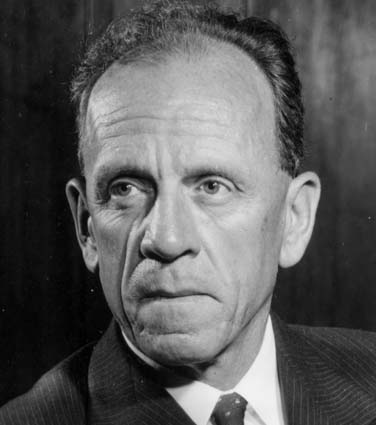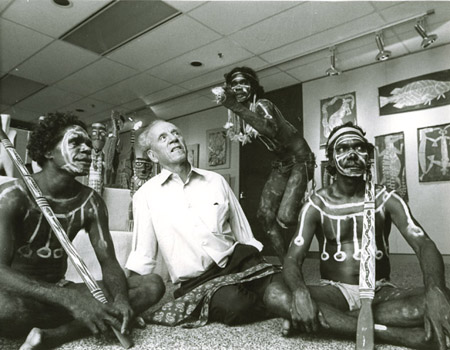HC Nugget Coombs - The First Governor of the RBA and Far More Than A Civil Servant

Herbert Cole “Nugget” Coombs is best known to numismatists as the first Governor of the Reserve Bank of Australia, and by extension as a signatory on Australia’s banknotes for several decades. In the broader community however, Coombs is highly regarded for a much wider range of significant civic contributions across several diverse areas.
Many numismatists will be surprised to learn that Coombs’ working life both before and after he was a signatory on our banknotes spanned no less than five different decades. Coombs had been in full-time employment for 22 years before becoming Governor of the Commonwealth Bank, and remained active for 27 years after he retired from the Reserve Bank of Australia.
Coombs held several key government roles during World War II, as well as during the period of economic recovery that followed. Coombs was Australia’s most senior banking official when our nation’s central banking operations were transferred to the Reserve Bank of Australia, as well as during the transition to decimal currency in 1966. Coombs is recognized as also having made significant contributions to education, the arts and indigenous rights during his lifetime - his contributions were so instrumental, he was described by former Prime Minister Bob Hawke as “one of the most important Australians this century.[1]”
Early Years of Academia
Coombs was born in Kalamunda on the outskirts of Perth in 1906, and was identified early in his schooling as having academic talent. He earned scholarships for both high school and teacher’s college, and began his working life as a teacher in 1927 at Katanning primary school. While teaching, Coombs studied part-time at the University of Western Australia for a Bachelor of Arts degree, which he completed with honours in economics. Coombs followed this with a Master of Arts, also at UWA.
This stage of Coombs’ life coincided with the depths of the Great Depression. He received a further scholarship to write a thesis in economic theory at the prestigious London School of Economics, one of the most highly respected academic institutions for economics in the world. His experience of this trip - both the knowledge gained but also his direct experience of poverty fundamentally shaped his outlook on the role that economics and banking should play in the life of the average person.
Working for Equal Contribution to the War Effort
Coombs returned to Australia in 1934 - he soon entered the public service via the Commonwealth Bank, and transferred to the Commonwealth Treasury as an economist in 1939. Over the next several decades, Coombs developed into a government policy maker who was fundamental to Australia’s post-war stability and prosperity. Prime Minister John Curtin appointed him to the Commonwealth Bank board in October 1941, while in 1942 Treasurer Ben Chifley appointed him as Director of Rationing.
Coombs related to his role in charge of rationing as that of ensuring that there was equity in the sacrifices made by Australians. The incredible costs of both World War I and the Great Depression remained fresh in the minds of many Australians, so the public discussion of just how all classes of the community contribute equally to the war effort was fundamental to national morale in challenging circumstances.
Chifley created a new ministry in 1943 - the Department of Post-War Reconstruction, and appointed Coombs as its Director-General. It was in this capacity that Coombs played a leading role in the preparation of the “White Paper on Full Employment in Australia”. This paper did much to shape Commonwealth government policy for the next three decades, and is described as being “the blueprint of the post-war Long Boom”[2] that ran from 1945 to 1975.
A Central Figure In An International Community
A good deal of Coombs attention during the post-war years was how Australia’s economic fortunes would be impacted by the actions of our major trading partners - Great Britain and the United States prime among them. International treaties defined the ends to which the world’s economies would be directed, and also the concessions they would make to each other. Coombs was chosen to represent Australia’s interests at a conference staged by the United Nations in May 1943, the purpose of which was to discuss how the world’s economies would interact and compete with each other.
Among the results of this conference was the establishment of the International Trade Organization (ITO) and the International Monetary Fund (IMF). Between 1943 and 1948, Coombs spent many months away from Australia participating in conferences and diplomatic meetings related to these events - his passport would have shown repeated stamps for London; Washington and Geneva, as well as for Havana and Sweden. During this time, Coombs became “…a central figure in an international community of government officials.[3]”
Governor of the Commonwealth Bank of Australia from 1949
 Once it became clear that the world’s post-war economic relationships had been formalised, Coombs was appointed as the Governor of the Commonwealth Bank of Australia. He started in this position on January 1st 1949, one that was regarded as being “…the most important post in the regulation of the Australian economy.[4]” Just prior to this appointment, Coombs had been offered the inaugural Vice-Chancellorship of the Australian National University, which was also being established at that time. In declining the Vice-Chancellor role, Coombs advised that “…`the Depression has been the most significant event in my life’… and that he was now engaged in preventing another.[5]”
Once it became clear that the world’s post-war economic relationships had been formalised, Coombs was appointed as the Governor of the Commonwealth Bank of Australia. He started in this position on January 1st 1949, one that was regarded as being “…the most important post in the regulation of the Australian economy.[4]” Just prior to this appointment, Coombs had been offered the inaugural Vice-Chancellorship of the Australian National University, which was also being established at that time. In declining the Vice-Chancellor role, Coombs advised that “…`the Depression has been the most significant event in my life’… and that he was now engaged in preventing another.[5]”
Coombs was as pleased with his new role at the Commonwealth Bank for personal as much as for professional reasons - by living in one place for an extended period of time, he would be able to see more of his family.
In personal correspondence at the time, Coombs joked to one Western Australian friend “The family think it's a good idea. I will be home more and we shall have our name on the pound notes. It's hard to say which is the more important to them.[6]”
The delight the Coombs family felt seeing their name on Australia’s currency notes was a recurring theme in Nugget’s responses to the congratulatory notes he received after being appointed to the CBA role. To another he wrote that “the kids think that [him being at home is] nearly as good as having their name on the pound notes.[7]”
According to the Reserve Bank of Australia historian, Boris Schedvin, one of Dr Coombs’ finest achievements was building a central bank in Australia “that could compare with the best in the world … in the 1950s the Bank became a prestigious place in which to work. The quality of economic intelligence was greatly improved, and economic debate flourished.[8]”
Australia’s economy grew strongly in the peace that followed WWII, this growth was reflected in the size and strength of the Commonwealth Bank. By the end of the 1950’s, the Commonwealth Bank had more than 650 branches, more than 6,500 agencies and more than 14,000 staff.[9]
One consequence of this growth was an unyielding pressure to separate the central bank functions of the Commonwealth Bank from its operations as a trading and savings bank. Although some legislative changes were introduced in 1953, pressure mounted on the government to completely separate the central bank’s operations from those that were in commercial competition with the private-enterprise banks.
Australia’s Most Senior Central Banker
In 1957, Prime Minister Menzies announced legislation that would do just that, and on January 14th 1960, the Commonwealth Bank was split into the Reserve Bank of Australia and the Commonwealth Banking Corporation.
Nugget Coombs was appointed as the inaugural Governor of the Reserve Bank of Australia. One notable moment of guidance by Coombs to the RBA’s operations was his advice that a more flexible approach to interest rates would increase the effectiveness of monetary policy - these changes were implemented from the mid-1960’s onwards.[10]
Through his varied roles in public service, Coombs developed deep working relationships with no less than four prime ministers and eight treasurers, and became a key economic adviser to Curtin, Chifley, Menzies, Holt, McMahon and Whitlam.
Coombs stated that throughout his life as a public servant, one of his key commitments was to influence politicians in a way that they drafted economic policies that were inclusive of all Australians - this commitment can be seen in his approach to managing rations during WWII, the outcomes he pushed for regarding the ITO, as well as the need for the Reserve Bank to be as effective as possible with monetary policy.
A Second Career After Banking
Coombs retired as a public servant in 1968, however continued to make significant contributions to civic life for a further three decades. 
After stepping down from the Reserve Bank, Dr Coombs was appointed by Prime Minister Harold Holt as Chairman of the Council for Aboriginal Affairs, as well as the Chairman of the Council for the Arts. Coombs also assumed the role of Chancellor of the Australian National University between 1968 to 1976.
A biography by the Australian Academy of Science stated that “More than any other individual, he was responsible for the formation of the Australian National University…”[11], while one arts body describes Coombs as “The most influential arts administrator this country has so far produced“[12] For his tireless contribution to indigenous self-determination, Coombs was described by the ATSIC Social Justice Commissioner Mick Dodson as an elder that “… draws respect and love from all Indigenous Australians who know his story.[13]”
Coombs remained very active until he suffered a stroke at the age of 89, and passed away at the age of 91. One obituary stated that “Coombs was probably the most outstanding civil servant Australia has produced, but he will be remembered for being more than a civil servant.[14]”
Nugget’s Set of Specimen Banknotes
The Nugget Coombs estate was handled by Goodman’s auction house in the Sydney suburb of Double Bay in October 1998. Nine different lots of specimen banknotes that had been presented to Coombs were included, either sets or single notes.
Lot 181 was a set of four specimen notes (ten shilling, one pound, five pounds and ten pounds) dating to 1949 and featuring the signatures of Coombs and Watt, these notes were housed in a “plush presentation album”. Although several specimen notes from the King George V and Elizabeth II periods had been seen at auction as early as 1980, this was the first auction to make specimen notes from the King George VI era available to collectors, there was much excitement in the market as a result.
Several price records were set during the Goodman auction, which set the tone for how Nugget’s notes would be received by collectors at later auctions also.
In spite of easing values in this segment of the numismatic market, the rarity of these has not diminished one iota - just three individual specimen notes from the King George VI period have been seen at auction in the past 5 years.
[1]http://www.independent.co.uk/news/obituaries/obituary-h-c-coombs-1291452.html
[2]Rowse; Tim, "Nugget Coombs - A Reforming Life", Cambridge University Press, Cambridge, 2002, p 108.
[3]Rowse; Tim, "Nugget Coombs - A Reforming Life", Cambridge University Press, Cambridge, 2002, p 140.
[4]Houldsworth; Marion, "Maybe It'll Rain Tomorrow", Central Queensland University Press, Rockhampton, 2007, p 201.
[5]Rowse; Tim, "Nugget Coombs - A Reforming Life", Cambridge University Press, Cambridge, 2002, p 177.
[6]Rowse; Tim, "Nugget Coombs - A Reforming Life", Cambridge University Press, Cambridge, 2002, p 181.
[7]Rowse; Tim, "Nugget Coombs - A Reforming Life", Cambridge University Press, Cambridge, 2002, p 181.
[8]Schedvin; Boris, "In Reserve", Allen & Unwin, Sydney, 1992.
[9]"The Commonwealth Banking Corporation", Commonwealth Banking Corporation, Sydney, 1980, p 54.
[10]Cornish; Selwyn, "History and the Development of Central Banking in Australia 1920-1970 ", Australian National University, Canberra, 2008, p 25.
[11]https://www.science.org.au/fellowship/fellows/biographical-memoirs/herbert-cole-coombs-1906-1997
[12]http://liveperformance.com.au/halloffame/hccoombs1.html
[13]https://www.humanrights.gov.au/news/speeches/assimilation-versus-self-determination-no-contest-dodson-1996
[14]http://www.independent.co.uk/news/obituaries/obituary-h-c-coombs-1291452.html
